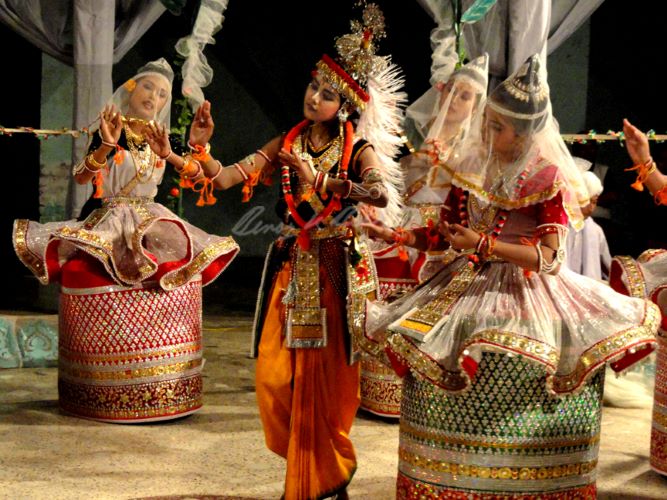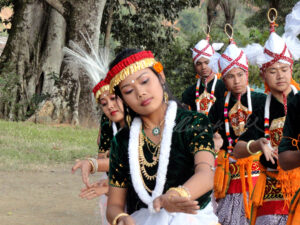IHC’s Glimpses of Culture series to present dancers of Manipur on June 25

Raas Lila. Pic. Benoy K Behl
Team L&M
Tucked away between lush green hills of North East India, the bejewelled; and Manipur has preserved many jewels of the ancient culture of India. The people of Manipur had a unique tradition of worship through the ecstasy of dance. Since they believed that they were the descendants of celestial musicians, Gandharvas, they sought communion with the Divine through music and dance. Manipuri dances are a unique and joyous form of worship, where the entire community comes together to express their devotion through dance. These dances are not performances but are an essential and integral part of religious practice.
The Bhakti cult of Vaishnuism spread throughout India in the medieval period. This believes in a very direct and personal love of the lord. The soul of man is seen pining in separation from him. The effort is always to lose oneself in adoration of the lord to become one with him. The philosophy of Vaishanuism was embraced by the people all over the plains of North Eastern India from the 15th century onwards. The oldest Vishnu temple in Manipur is at Bishnupur about 35 kms South West of Imphal. It was made in 1467 in the reign of King Kayamba. By the 17th century the people of Manipur had embraced the philosophy of Vaishnuism. They merged it with their ancient practices and exquisite religious dances.
In Indian philosophy, it has always been believed that the aesthetic experience, when one is transported and loses oneself in the beauty of nature or of art, is an experience akin to Brahmananda itself. It is in this moment that the ego, the preoccupation with the self, appears to fade away, and we truly feel that we are a part of the divinity of existence. It is in this manner that the Manipuri worshipper wishes to lose himself entirely through a complete absorption in his dance.

The purpose of the philosophic path is for us to be able to see the truth beyond. To lose our egos and our concerns in the material world: to rise up in awareness, to see the beauty of all that there is around us, to see that all is divine and therefore divinely beautiful…to lose ourselves in adoration of that beauty… One of the greatest embodiments of this exquisite philosophical quest is the Raas Lila of Manipur.
The dances of the Manipuri Raas Lila cover the life of Krishna from his childhood pranks and exploits to his dalliance with Radha and the gopis. Each dancer represents humanity’s pangs of separation from the Lord and the yearning to be united with Him. All humans are like the gopis, ever seeking, and desiring the Lord. The playful Lord is omnipresent and dances with all the Gopis simultaneously. Each gopi dances, lost in the belief that Krishna dances with her alone. Finally the bhakt and the Lord are united in the dance of Krishna and Radha.
Krishna, the word comes from the root of “Akarshan”, “attraction”. He is the personification of our attraction to the divine. It is most marvellous to see how Indian philosophic paths use the entire range of human emotions, to lead us always to that which is beyond. There is no denial of human warmth in Indian worship. Even our feelings of love are used to take us in a seamless path, towards divine knowledge.
In Indian thought, the material world around us and our day-to-day concerns are considered to be Maya or Mithya illusions. We perceive these illusions because of our limited sensibilities. The purpose of the philosophic path is for us to be able to see the truth beyond. To lose our egos and our concerns in the material world. To rise up in awareness, to see the beauty of all that there is around us, to see that all is divine and therefore divinely beautiful…to lose ourselves in adoration of that beauty… One of the greatest embodiments of this exquisite philosophical quest is the Raas Lila of Manipur.
For the Vaishnavs of Manipur, the Sankirtan, including the Raas Lila, is their worship and puja. All the important occasions of life are marked by the performance of the Sankirtan, be it a birth, a wedding or a passing away. They lose their material concerns and are fully absorbed in the adoration of the deity. It is believed that the ground upon which the Ras Lila is performed becomes Brindavan. The Bhakts keep and treasure the dust which has thus been made sacred.
Under its Glimpses of Culture programme, India Habitat Centre is presenting a
film Celestial Dancers of Manipur on June 25 at 6pm. The film was produced by
Art Historian, Film-maker & Photographer Benoy K Behl for Doordarshan.
To watch join here


